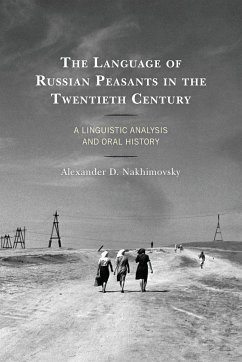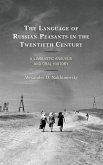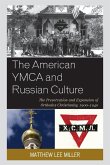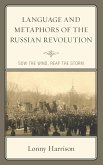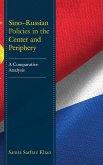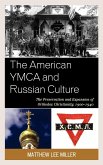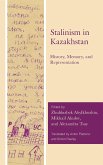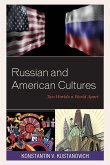Alexander D. Nakhimovsky
The Language of Russian Peasants in the Twentieth Century
A Linguistic Analysis and Oral History
Alexander D. Nakhimovsky
The Language of Russian Peasants in the Twentieth Century
A Linguistic Analysis and Oral History
- Broschiertes Buch
- Merkliste
- Auf die Merkliste
- Bewerten Bewerten
- Teilen
- Produkt teilen
- Produkterinnerung
- Produkterinnerung
This book analyzes the social dialect of Russian peasants in the twentieth century through their letters and stories. It constitutes an oral history of peasants' tragic Soviet past, and argues that for all their variability, local peasant dialects maintained an underlying unity throughout the century.
Andere Kunden interessierten sich auch für
![The Language of Russian Peasants in the Twentieth Century The Language of Russian Peasants in the Twentieth Century]() Alexander D. NakhimovskyThe Language of Russian Peasants in the Twentieth Century118,99 €
Alexander D. NakhimovskyThe Language of Russian Peasants in the Twentieth Century118,99 €![The American YMCA and Russian Culture The American YMCA and Russian Culture]() Matthew Lee MillerThe American YMCA and Russian Culture73,99 €
Matthew Lee MillerThe American YMCA and Russian Culture73,99 €![Language and Metaphors of the Russian Revolution Language and Metaphors of the Russian Revolution]() Lonny HarrisonLanguage and Metaphors of the Russian Revolution124,99 €
Lonny HarrisonLanguage and Metaphors of the Russian Revolution124,99 €![Sino-Russian Policies in the Center and Periphery Sino-Russian Policies in the Center and Periphery]() Samra Sarfraz KhanSino-Russian Policies in the Center and Periphery108,99 €
Samra Sarfraz KhanSino-Russian Policies in the Center and Periphery108,99 €![The American YMCA and Russian Culture The American YMCA and Russian Culture]() Matthew Lee MillerThe American YMCA and Russian Culture141,99 €
Matthew Lee MillerThe American YMCA and Russian Culture141,99 €![Stalinism in Kazakhstan Stalinism in Kazakhstan]() Stalinism in Kazakhstan109,99 €
Stalinism in Kazakhstan109,99 €![Russian and American Cultures Russian and American Cultures]() Konstantin V. KustanovichRussian and American Cultures44,99 €
Konstantin V. KustanovichRussian and American Cultures44,99 €-
-
-
This book analyzes the social dialect of Russian peasants in the twentieth century through their letters and stories. It constitutes an oral history of peasants' tragic Soviet past, and argues that for all their variability, local peasant dialects maintained an underlying unity throughout the century.
Produktdetails
- Produktdetails
- Verlag: Lexington Books
- Seitenzahl: 226
- Erscheinungstermin: 4. März 2022
- Englisch
- Abmessung: 229mm x 152mm x 13mm
- Gewicht: 374g
- ISBN-13: 9781498575058
- ISBN-10: 1498575056
- Artikelnr.: 63299427
- Herstellerkennzeichnung
- Libri GmbH
- Europaallee 1
- 36244 Bad Hersfeld
- gpsr@libri.de
- Verlag: Lexington Books
- Seitenzahl: 226
- Erscheinungstermin: 4. März 2022
- Englisch
- Abmessung: 229mm x 152mm x 13mm
- Gewicht: 374g
- ISBN-13: 9781498575058
- ISBN-10: 1498575056
- Artikelnr.: 63299427
- Herstellerkennzeichnung
- Libri GmbH
- Europaallee 1
- 36244 Bad Hersfeld
- gpsr@libri.de
By Alexander D. Nakhimovsky
Chapter 1. The language of Russian peasants as a social dialect
1.1 Introduction: The language of peasants
1.2 Peasant language before 1917
1.3 Examples from Bogoraz, Tenishev
1.4 An initial generalization: the peasant language profile
1.5 A longer story from 1925
Conclusions
Chapter 2. Peasants and Bolsheviks, 1917-1928
2.1 Introduction: The impact of the revolution
2.2 Letters to power: long history pre-1905
2.3 The revolution of 1905 and new kinds of letters
2.4 Linguistic background: Phraseology, Formulaic language
2.5 Revolution and civil war, 1917-21
2.6 Bolshevik innovations and peasant attitudes
2.7 Available peasant materials, 1917-1921-1928
2.8 Directions of change
2.9 Categories and examples
Conclusions
Chapter 3. Personal letters 1939-1940
3.1 Introduction: the source and the background
3.2 Letters to the army and peasant moods
3.3 Personal letters as a genre: tradition, structure and formal elements
3.4 The source and the historical background
3.5 Examples of letters 1: three generations
3.6. Examples of letters 2: Old people
3.7 Examples of letters 3: Recent peasants and some success stories
3.8 The defining features of peasant letters
3.9 On literacy and letters from schoolchildren
3.10 Discourse and pragmatic features
3.11 Overlap and interpenetration with other social groups
3.12 Vocabulary, syntax, phraseology
Conclusions
Chapter 4. Scholars and narratives from the 1950s to today
4.1 A longer timeframe, the endangered language
4.2 Biographic narratives as historical testimony
4.3 Examples, grouped by history
4.4 The linguistics of peasant narratives
Conclusions: the unity of peasant language
1.1 Introduction: The language of peasants
1.2 Peasant language before 1917
1.3 Examples from Bogoraz, Tenishev
1.4 An initial generalization: the peasant language profile
1.5 A longer story from 1925
Conclusions
Chapter 2. Peasants and Bolsheviks, 1917-1928
2.1 Introduction: The impact of the revolution
2.2 Letters to power: long history pre-1905
2.3 The revolution of 1905 and new kinds of letters
2.4 Linguistic background: Phraseology, Formulaic language
2.5 Revolution and civil war, 1917-21
2.6 Bolshevik innovations and peasant attitudes
2.7 Available peasant materials, 1917-1921-1928
2.8 Directions of change
2.9 Categories and examples
Conclusions
Chapter 3. Personal letters 1939-1940
3.1 Introduction: the source and the background
3.2 Letters to the army and peasant moods
3.3 Personal letters as a genre: tradition, structure and formal elements
3.4 The source and the historical background
3.5 Examples of letters 1: three generations
3.6. Examples of letters 2: Old people
3.7 Examples of letters 3: Recent peasants and some success stories
3.8 The defining features of peasant letters
3.9 On literacy and letters from schoolchildren
3.10 Discourse and pragmatic features
3.11 Overlap and interpenetration with other social groups
3.12 Vocabulary, syntax, phraseology
Conclusions
Chapter 4. Scholars and narratives from the 1950s to today
4.1 A longer timeframe, the endangered language
4.2 Biographic narratives as historical testimony
4.3 Examples, grouped by history
4.4 The linguistics of peasant narratives
Conclusions: the unity of peasant language
Chapter 1. The language of Russian peasants as a social dialect
1.1 Introduction: The language of peasants
1.2 Peasant language before 1917
1.3 Examples from Bogoraz, Tenishev
1.4 An initial generalization: the peasant language profile
1.5 A longer story from 1925
Conclusions
Chapter 2. Peasants and Bolsheviks, 1917-1928
2.1 Introduction: The impact of the revolution
2.2 Letters to power: long history pre-1905
2.3 The revolution of 1905 and new kinds of letters
2.4 Linguistic background: Phraseology, Formulaic language
2.5 Revolution and civil war, 1917-21
2.6 Bolshevik innovations and peasant attitudes
2.7 Available peasant materials, 1917-1921-1928
2.8 Directions of change
2.9 Categories and examples
Conclusions
Chapter 3. Personal letters 1939-1940
3.1 Introduction: the source and the background
3.2 Letters to the army and peasant moods
3.3 Personal letters as a genre: tradition, structure and formal elements
3.4 The source and the historical background
3.5 Examples of letters 1: three generations
3.6. Examples of letters 2: Old people
3.7 Examples of letters 3: Recent peasants and some success stories
3.8 The defining features of peasant letters
3.9 On literacy and letters from schoolchildren
3.10 Discourse and pragmatic features
3.11 Overlap and interpenetration with other social groups
3.12 Vocabulary, syntax, phraseology
Conclusions
Chapter 4. Scholars and narratives from the 1950s to today
4.1 A longer timeframe, the endangered language
4.2 Biographic narratives as historical testimony
4.3 Examples, grouped by history
4.4 The linguistics of peasant narratives
Conclusions: the unity of peasant language
1.1 Introduction: The language of peasants
1.2 Peasant language before 1917
1.3 Examples from Bogoraz, Tenishev
1.4 An initial generalization: the peasant language profile
1.5 A longer story from 1925
Conclusions
Chapter 2. Peasants and Bolsheviks, 1917-1928
2.1 Introduction: The impact of the revolution
2.2 Letters to power: long history pre-1905
2.3 The revolution of 1905 and new kinds of letters
2.4 Linguistic background: Phraseology, Formulaic language
2.5 Revolution and civil war, 1917-21
2.6 Bolshevik innovations and peasant attitudes
2.7 Available peasant materials, 1917-1921-1928
2.8 Directions of change
2.9 Categories and examples
Conclusions
Chapter 3. Personal letters 1939-1940
3.1 Introduction: the source and the background
3.2 Letters to the army and peasant moods
3.3 Personal letters as a genre: tradition, structure and formal elements
3.4 The source and the historical background
3.5 Examples of letters 1: three generations
3.6. Examples of letters 2: Old people
3.7 Examples of letters 3: Recent peasants and some success stories
3.8 The defining features of peasant letters
3.9 On literacy and letters from schoolchildren
3.10 Discourse and pragmatic features
3.11 Overlap and interpenetration with other social groups
3.12 Vocabulary, syntax, phraseology
Conclusions
Chapter 4. Scholars and narratives from the 1950s to today
4.1 A longer timeframe, the endangered language
4.2 Biographic narratives as historical testimony
4.3 Examples, grouped by history
4.4 The linguistics of peasant narratives
Conclusions: the unity of peasant language

